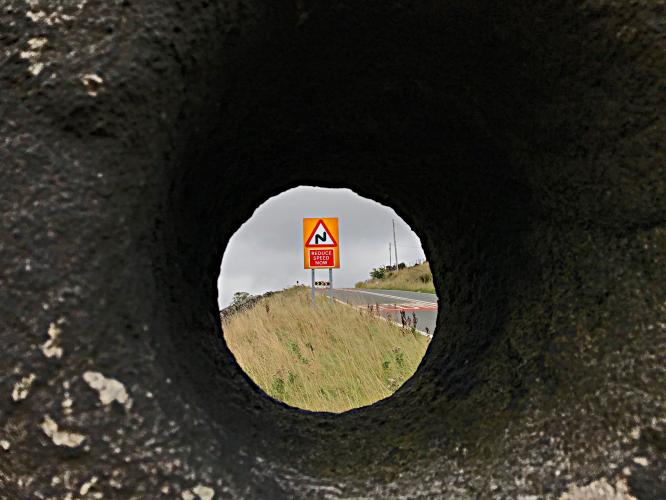![]()
Cycling Holm Moss
Ride 2.2 kilometers gaining 200 meters at 9.2% average grade.
![]()
Another of the 100 Greatest Cycling Climbs that has been included in the British National Hill Climb Championships. Holme Moss was the site of the 1954 National Hill Climb Championship (Les Ingman) and 1974 (Joe Waugh). This is also one of the few climbs in Britain to have been included in the Tour de France. Holme Moss was part of Stage 2 of the 2014 Tour de France (leader at summit Blel Kadri, France). Stage 2 Overview:
“TOUR DE FRANCE 2014 ROUTE STAGE 2: YORK (GB) - SHEFFIELD (GB). Sunday, July 6th – Stage 2 of the 2014 Tour de France travels from York to Sheffield. The stage of 201 kilometres long and features some touch climbs reminiscent of the Ardennes.
The stage starts in the historical city of York, founded by the Romans in 71 AD.
Upon leaving York, the bunch goes west and passes yesterday’s start town of Leeds. The stage is a very bumpy one, surprisingly so for so early in the Tour. It’s like an English version of Liege-Bastogne-Liege with about 20 climbs in total.
![]()
Today’s main hills: The biggest climb of the day is Holme Moss after 150 kilometres. Officially the climb is 16 kilometres long but the first 10 are really a false flat. Gradually the gradient goes up and reaches 14% near the summit.” CyclingStage.com
![]()
Holme Moss was also included in the 1988 and 2005 Tour of Britain.
![]()
2008 Tour of Britain - Holme Moss climb; photo Chris Walker
And, last, but maybe not least, Holm Moss has been included in the Leeds International Classic (race held from 1989-1997).
The thing that stuck out most about this climb was the plethora of road warning signs along the way. The climb is along Highway A6024 and we suspect there have been some severe automobile accidents over time that has prompted peppering the route with speed, turn and hazard signs.
![]()
The climb is a fairly constant 7-10% with the steepest section popping up to 13.4% for 200 meters at km 1.5. There are 100 meter markers along the way that appeared fairly new (within a the last 5 years for sure).
You will know when you are at the top.
![]()
Finish.
The road is in pristine condition but since it is a highway and a pass, there is a fair amount of traffic. It was foggy and very windy on the day we climbed in September, 2018.
![]()
Steepest ½ kilometer starts at 1.1 kilometers (12%)
This climb begins just 800 meters south of Holme and is #43 on Simon Warren’s 100 Greatest Cycling Climbs.
“Stage two | 143km | Holmfirth | Rating: 7/10
I originally rated this climb a 5/10. What was I thinking! Returning to ride it for the first time in five years I can only conclude that I must have had a huge tail wind, as it’s definitely a seven.
Holme Moss won’t decide the winner of the day’s stage but it will shake things up and could provide the launch pad for a serious attack.
Leaving Holmfirth on the A6024 you climb hard through Hinchcliffe Mill and Holmbridge, but I measure the actual ascent of Holme Moss from the small bridge just past the exit of Holme.
Being a major route across the Pennines the road is wide, well surfaced and covered with warning signs. You’re bombarded with signals to slow, arrows marking direction and more usefully, markers counting down the distance to the exposed summit.
Starting from one mile to go, these marks on the road will take you all the way to the ‘finish line’ acting as carrots to aim for as you grind, or if you’ve good legs, spin up the solid, unrelenting 10-12% gradient.” http://www.cyclingweekly.com/news/racing/tour-de-france/cote-de-holme-moss-10-greatest-tour-cycling-climbs-yorkshire-128168
Wikipedia - Holme Moss:
“Holme Moss (1,719 feet or 524 metres a.s.l.) is high moorland on the border between the Holme Valley district of Kirklees in West Yorkshire and the High Peak district of Derbyshire in England. Historically on the boundary between the West Riding of Yorkshire and Cheshire, it is just inside the boundary of the Peak District National Park. The A6024 road between Holmfirth and Longdendale crosses the moor near its highest point close to Holme Moss transmitting station's prominent mast.” more
The climb is located in Peak District National Park - the UK’s first national park:
“The Peak District National Park became the first national park in the United Kingdom in 1951. With its proximity to the cities of Manchester, Stoke-on-Trent, Derby and Sheffield, and easy access by road and rail, it attracts millions of visitors every year.” https://en.wikipedia.org/wiki/Peak_District

 We've partnered with Sherpa-Map.com to bring you the best route planning tool. With a PRO Membership you can use this climb as a reference when creating your route.
We've partnered with Sherpa-Map.com to bring you the best route planning tool. With a PRO Membership you can use this climb as a reference when creating your route. 

